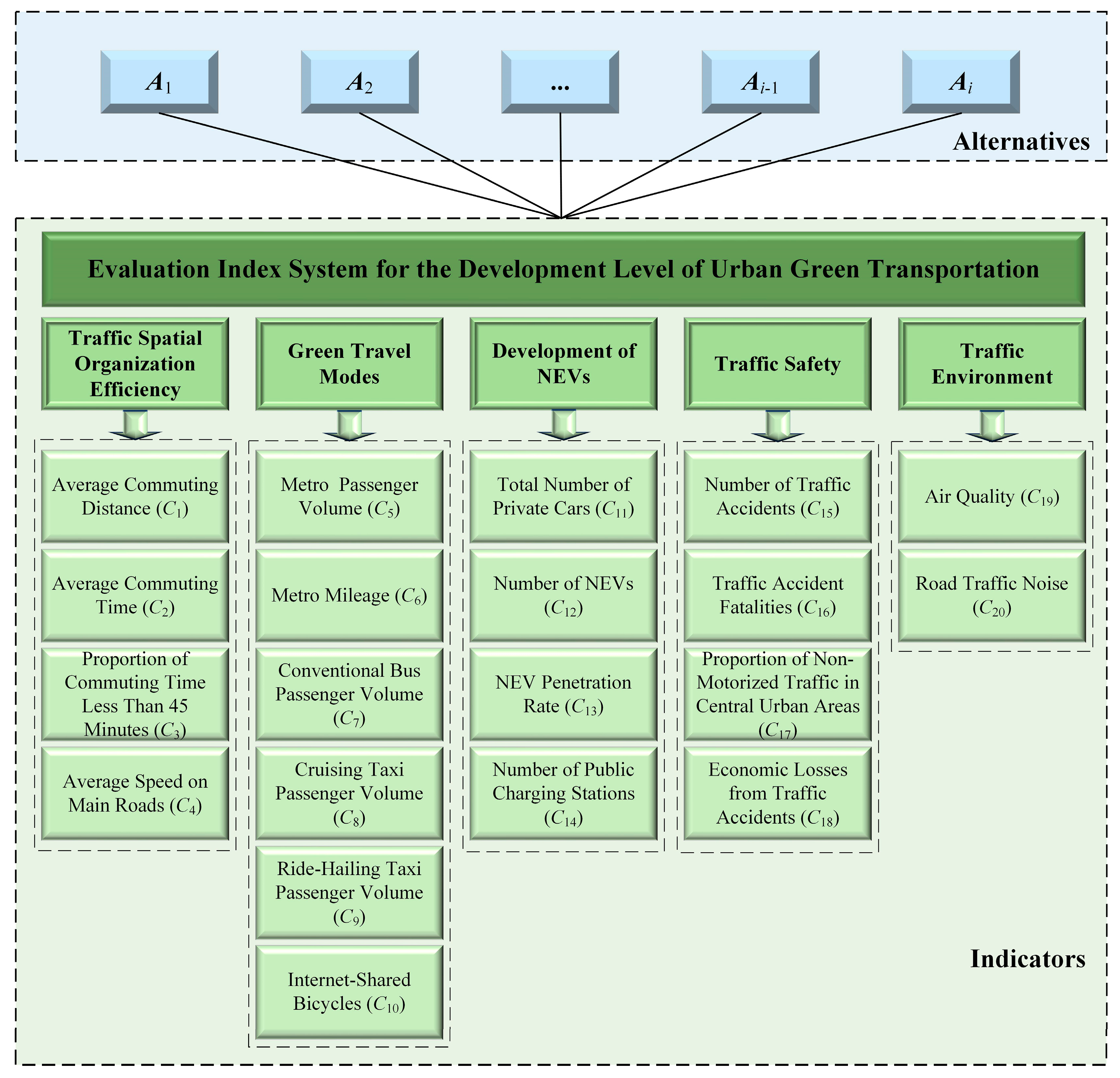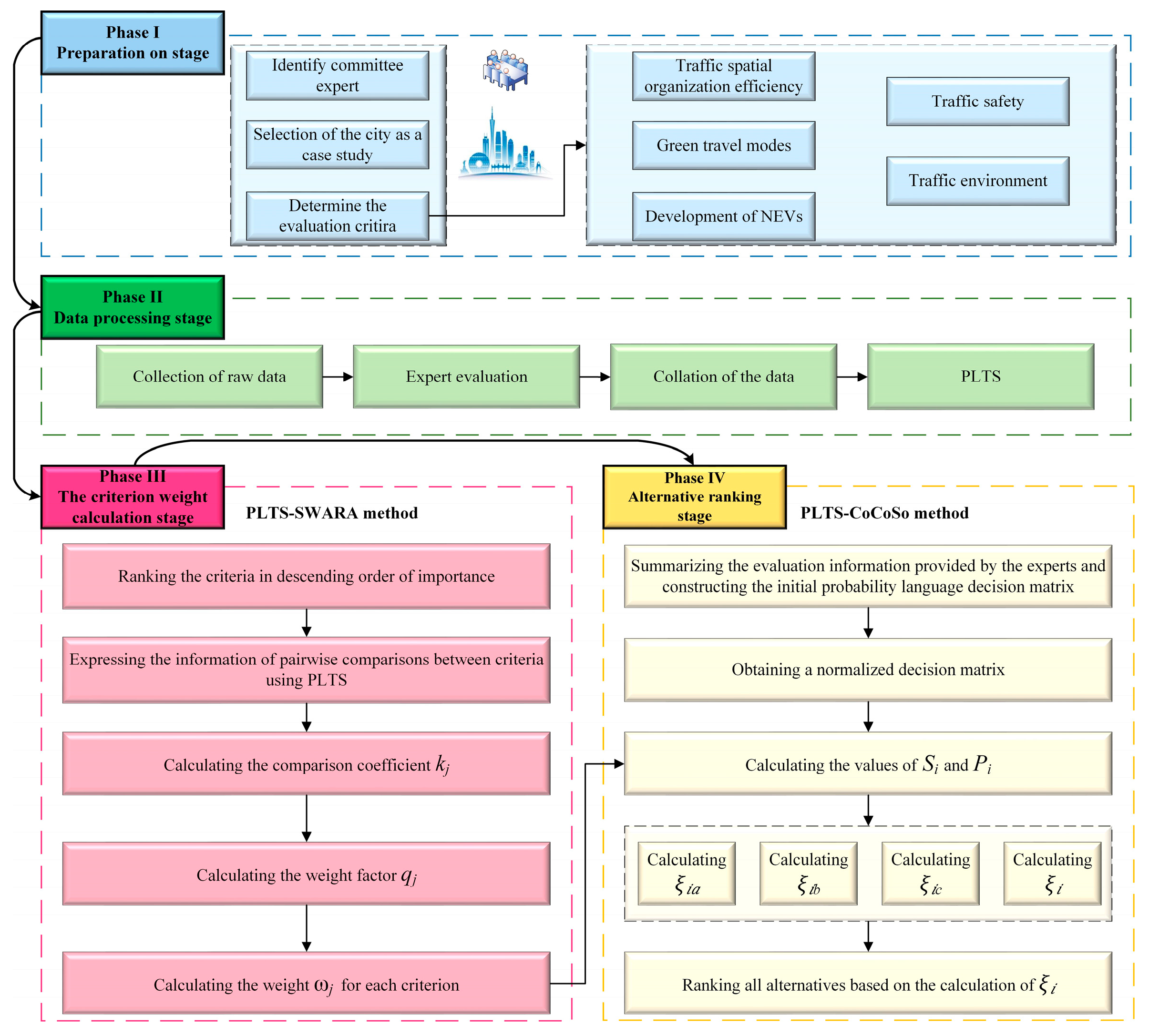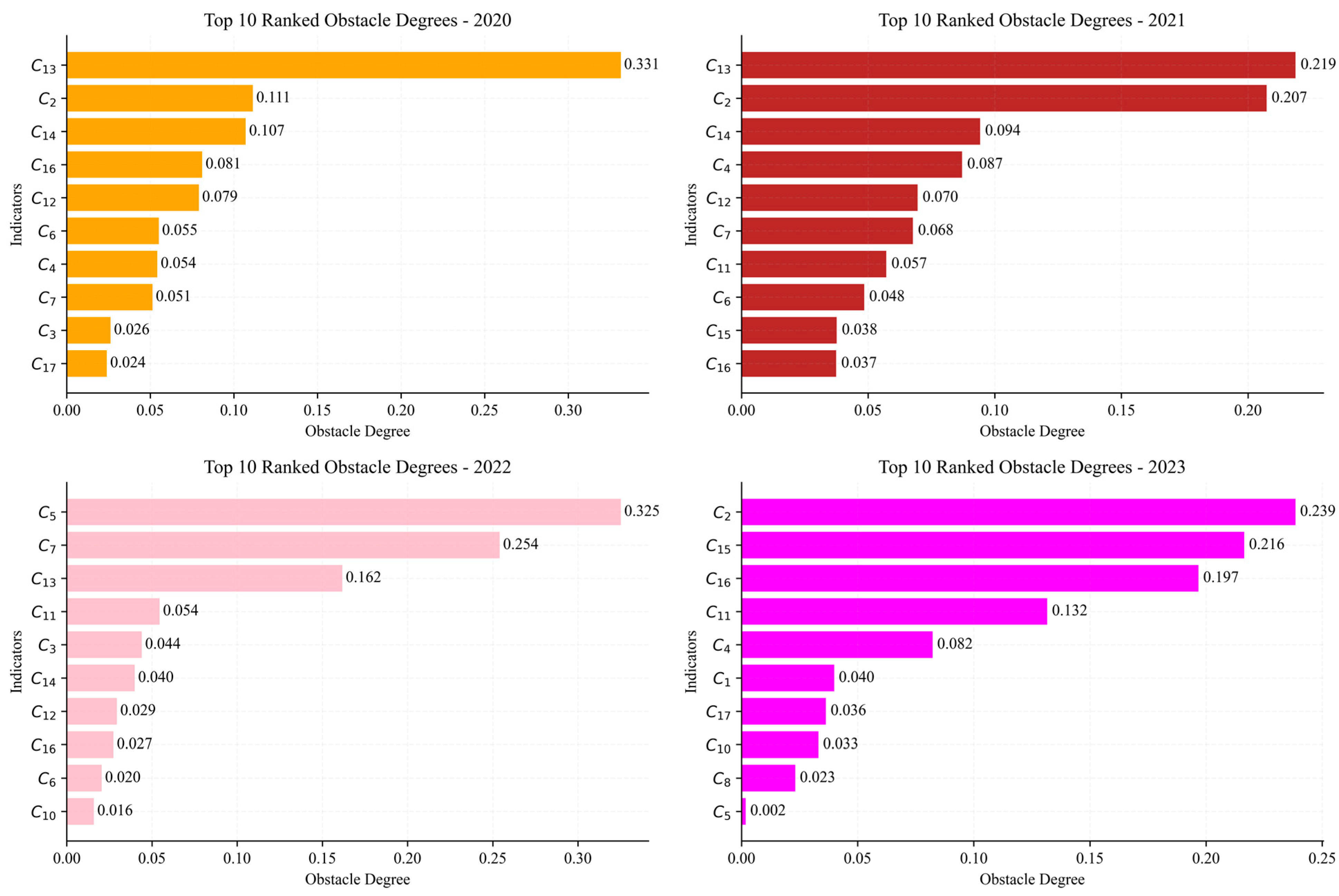1. Introduction
With the increasingly severe global climate change and energy crisis, new energy vehicles (NEVs), as important green transportation tools, have become key measures in the green transformation of urban transport. In November 2020, the Chinese government released the “New Energy Vehicle Industry Development Plan (2021–2035)” with the target of achieving a 40% market penetration rate for (NEVs) by 2030 to promote energy transition and sustainable development in the transportation sector [
1]. Driven by this policy, the promotion of NEVs in major cities across China has made significant progress, becoming an important part of the green transportation system. However, as NEVs become more widespread, the sole focus on “NEV promotion” will no longer be the key limiting factor for urban green transportation development. Other bottlenecks, such as transportation infrastructure construction, the optimization of public transport systems, and transportation behaviors, may become significant obstacles to further urban green transportation development. Therefore, how to comprehensively evaluate and identify the current status and potential constraints of urban green transportation development under the promotion of NEVs will provide guidance for the improvement and implementation of future urban green transportation policies.
The evaluation of the urban green transportation development level (UGTDL) has become a popular research topic. Several studies have explored this topic [
2,
3,
4,
5,
6,
7,
8,
9] (as shown in
Table 1). According to the findings of reference [
2], Yuzhong is identified as the district with the highest level of green transportation development in Chongqing, while Jiulongpo is ranked the lowest. The assessment results in reference [
3] reveal that the green transportation development level in Lanzhou experienced a rise, followed by a decline and then another rise from 2011 to 2017, indicating an overall upward trend. Reference [
4] indicates that from 2015 to 2019, Wuhan’s green transportation development level exhibited a slight fluctuation with an overall increasing trend, achieving a comprehensive growth of 61.3%. The main limiting factors influencing this development shifted from the proportion of NEVs, public transportation share, and transportation noise levels to indicators such as per capita road area and pedestrian pathway area. Reference [
5] evaluates Harbin’s green transportation in 2021 as being at a “good” level, though its public transport service still requires further improvement. Reference [
6], which analyzed 30 provincial capital and central cities in China, reports an average composite score of 2.871 for green transportation development, suggesting a moderate level overall. Between 2011 and 2020, the cities’ scores showed a trend of “initial decline—fluctuating rise—subsequent decline”. Reference [
7] finds that Zhoushan’s green transportation development in 2017 outperformed that of 2018 and was also superior to that in 2016. The study in reference [
8] identifies total passenger transport volume, taxi ownership, NEV production, transport expenditure, and freight volume as the main obstacles to the UGTDL in China’s national central cities. Finally, reference [
9] highlights that public transportation services are the primary driver of sustainable urban green transportation development.
According to
Table 1, the existing studies mostly focus on general cities or specific types of cities, such as mountainous cities or valley-type cities, while there is relatively little research on megacities with significant transportation environmental problems. Furthermore, most of the existing studies have employed Multi-Criteria Decision Analysis (MCDA) methods such as AHP, the entropy method, TOPSIS, and PROMETHEE to evaluate the UGTDL, indicating that UGTDL evaluation is a typical MCDA problem. However, with the continuous development of MCDA methods, novel and advanced MCDA models have been widely developed and applied in supply chain management [
10], financial engineering [
11,
12], the hydrological environment [
13], aviation transportation [
14], biomedical engineering [
15], and energy management [
16]. In comparison, the development of urban green transportation evaluation models has been relatively slow. There is a clear need for the development of new MCDA models that provide better evaluation results in urban green transportation evaluation. Typically, the construction of an MCDA model involves three issues: (1) the representation of evaluation information, which refers to the appropriate quantification of indicators for the evaluation object; (2) the determination of the weights of indicators; and (3) the ranking of the evaluation objects.
Regarding the representation of evaluation information, due to the complexity, fuzziness, and multi-level nature of the real-world decision-making environment, decision information is often difficult to express using precise real numbers [
17]. Therefore, Zadeh [
18] proposed the concept of Linguistic Term Sets (LTSs) to represent fuzzy decision information, expanding the application of decision theory [
19]. Subsequently, scholars proposed various new types of LTS, such as 2-tuple LTS [
20], Pythagorean fuzzy linguistic sets (PFLS) [
21], intuitionistic fuzzy linguistic sets (IFLSs) [
22], and hesitant fuzzy linguistic term sets (HFLTS) [
23], to deal with the uncertainty and hesitation in decision making. However, these LTSs do not consider the frequency or importance of linguistic term elements (LTEs) in decision information. Therefore, Pang et al. [
24] introduced the Probability Language Term Set (PLTS) and its basic operations to address this gap. The PLTS can reduce the information loss and more accurately express the probabilistic information of linguistic terms when dealing with complex decision problems, thus improving the accuracy and reliability of decision analysis. As a result, the PLTS is introduced to represent expert evaluation information on the specific indicator dimensions of the UGTDL.
The calculation of indicator weights mainly includes objective and subjective methods. The common objective weighting methods include the entropy method [
4,
8,
25], CRiteria Importance Through Intercriteria Correlation (CRITIC) [
26], MEthod based on the Removal Effects of Criteria (MEREC) [
27], while common subjective weighting methods include AHP [
2,
5], the Best Worst Method (BWM) [
28], and Step-wise Weight Assessment Ratio Analysis (SWARA) [
29]. Objective weighting methods typically consider only the characteristics of the data in the decision matrix, which can lack decision flexibility and ignore the decision maker’s preferences. Therefore, objective weighting methods are not suitable for policy-oriented evaluation problems. In subjective weighting methods, AHP requires multiple pairwise comparisons between indicators, which significantly increases the computational complexity when there are many indicators. Additionally, AHP often requires consistency checks, further complicating its application in practical evaluation problems [
30]. The BWM, as a newer subjective weighting method, offers computational convenience compared to AHP but still requires multiple pairwise comparisons when facing decision problems with many indicators [
31]. SWARA, however, only requires pairwise comparisons between a small number of indicators, greatly reducing the difficulty of weighting calculations in high-dimensional MCDA problems. Furthermore, the application of SWARA in MCDA has been proven to be stable and reliable in numerous studies [
32,
33,
34]. Given the large number of indicators considered in the UGTDL evaluation system, the SWARA method is chosen to simplify the computation process while ensuring the reasonableness of the weight calculation results.
In the context of NEV promotion, many ranking methods (e.g., TOPSIS, VIKOR, and PROMETHEE) have been applied to various decision-making problems, such as shared car station location selection [
35], NEV supplier selection [
36], and autonomous vehicle risk assessment [
37]. For instance, the Technique for Order Preference by Similarity to Ideal Solution (TOPSIS) ranks alternatives based on their geometric distance to ideal and anti-ideal solutions; the VlseKriterijuska Optimizacija I Komoromisno Resenje (VIKOR) method is based on a compromise solution and ranks alternatives with conflicting criteria; and the Preference Ranking Organization Method for Enrichment Evaluation (PROMETHEE) employs a pairwise comparison-based approach using preference functions to evaluate the alternatives. However, these traditional methods are often compensatory, meaning that a poor performance in one criterion can be offset by a good performance in another, which may lead to biased decisions in complex, real-world problems.
In comparison, the Combined Compromise Solution (CoCoSo) method [
38], which is based on a combination and compromise perspective, offers advantages such as avoiding compensatory issues in decision making, achieving an internal balance in the final utility, and relatively low computational complexity. The calculation results of CoCoSo have been proven stable and reliable in many decision-making fields [
39,
40,
41]. Therefore, the CoCoSo method is applicable to solve the calculation and ranking problem of the UGTDL.
In summary, Guangzhou is taken as a case study, and the PLTS-SWARA-CoCoSo model is constructed to evaluate the city’s UGTDL from 2020 to 2023. This study offers several novel contributions to the evaluation of the UGTDL, both methodologically and in its application to megacities.
- (1)
It is the first to introduce the PLTS into the evaluation of the UGTDL, addressing the issue of uncertainty in representing the evaluation information in the existing studies.
- (2)
It constructs a PLTS-based SWARA-CoCoSo combined model to handle the weighting and ranking problems in the UGTDL evaluation, overcoming the limitations of the traditional methods in handling high-dimensional indicators while avoiding the compensatory issues in decision making.
- (3)
On the basis of further improving the green transportation evaluation indicator system, the UGTDL of Guangzhou is evaluated, thereby filling the gap in the research on the UGTDL evaluation for megacities.
The following sections are organized as follows:
Section 2 constructs the evaluation indicator system for the UGTDL;
Section 3 establishes the PLTS-based SWARA-CoCoSo evaluation model;
Section 4 calculates the UGTDL of Guangzhou from 2020 to 2023 as a case study and verifies the effectiveness and stability of the model through sensitivity analysis;
Section 5 analyzes Guangzhou’s green transportation development status and proposes policy recommendations;
Section 6 summarizes the paper and provides the future research directions.
2. The UGTDL Evaluation Index System
The existing studies on the UGTDL evaluation systems typically focus on the macro-level indicators, such as the urban GDP, carbon emissions, transportation infrastructure development, and public transportation systems [
2,
3,
4,
5,
6,
7,
8,
9]. However, these studies often neglect the micro-level indicators, such as citizens’ green travel habits and urban commuting conditions, which somewhat limits the comprehensiveness and accuracy of the evaluation systems. Therefore, based on the existing research and incorporating the micro-level indicators, a new UGTDL evaluation index system is proposed. This system consists of five primary indicators: transportation spatial organization efficiency, green travel, the development of NEVs, transportation safety, and the transportation environment (as shown in
Figure 1). Each primary indicator is further subdivided into several secondary indicators, which are elaborated in detail below.
2.1. Traffic Spatial Organization Efficiency
The traffic spatial organization efficiency is reflected through four core indicators: average commuting distance (), average commuting time (), proportion of commuting within 45 min (), and average speed on main roads ().
The average commuting distance refers to the straight-line distance from the residence to the workplace (or school) for urban commuters, reflecting the rationality of the spatial layout of residential and employment areas in the city. According to the “2024 China Major Cities Commuting Monitoring Report” jointly released by the China Academy of Urban Planning and Design and Baidu Maps, a commuting distance within 5 km is defined as “happy commuting” [
42]. The average commuting time measures the time required for residents’ daily commute, influenced by factors such as city size, population density, and transportation modes. Generally, commuting times over 60 min are considered “extreme commuting”, which significantly affects residents’ quality of life [
42]. The proportion of commuting within 45 min measures the proportion of trips made within a reasonable commuting time (≤45 min). According to New York 2040—Planning a Strong and Just City, a 90% commuting rate within 45 min is an important standard for evaluating a city’s fairness and sustainable development [
43]. Finally, the average speed on main roads refers to the average traffic speed on the primary and secondary roads in the core urban area during the evening peak hours, reflecting the road capacity during commuting rush hours. The level of congestion increases significantly during peak times, and this indicator is used to assess the operational efficiency of urban road traffic.
2.2. Green Travel Modes
Green travel modes are assessed using six indicators: metro passenger volume (), metro mileage (), conventional bus passenger volume (), cruising taxi passenger volume (), ride-hailing taxi passenger volume (), and internet-shared bicycles ().
The metro passenger volume reflects the actual passenger capacity of the metro as the core mode of urban public transportation. Due to its high punctuality and stable operations, the metro is a preferred choice for commuters. Complementing this, metro mileage measures the coverage of the metro system and reflects the accessibility of public transportation. The economies of scale in metro networks become apparent once the system reaches a certain size, which in turn enhances its attractiveness for commuting. The conventional bus passenger volume reflects the actual carrying capacity of urban surface public transportation. As the main low-cost travel option for residents, the number of buses and the coverage of bus routes directly affect the variation in this indicator. The cruising taxi passenger volume evaluates the traditional taxi service that supplements public transport, though it is often subject to peak-hour imbalances due to the tidal nature of urban flows. In contrast, the ride-hailing taxi passenger volume reflects the growing adoption of app-based, algorithm-driven transport services that offer improved matching between supply and demand. Lastly, regarding the internet-shared bicycles as a “last mile” solution for public transportation [
44], the share of internet-shared bicycles has been increasing in short-distance travel. This mode is convenient, environmentally friendly, and aligns with the development trend of green transportation.
2.3. Development of NEVs
The development and adoption of NEVs are measured by reference to four indicators: the total number of private cars (), number of NEVs (), NEV penetration rate (), and the number of public charging stations ().
The total number of private cars reflects the degree of private motorization, which is directly linked to road congestion and environmental pressure. The number of NEVs quantifies the scale of clean-energy vehicle adoption, aligned with the national policies for pollution and carbon emission reduction [
45]. The NEV penetration rate, defined as the share of NEVs among all motor vehicles, serves as a direct measure of the greening of the urban transport fleet. Supporting infrastructure is captured by the number of public charging stations, which directly affects the convenience, usability, and continued growth of NEV ownership across the city.
2.4. Traffic Safety
Urban traffic safety is evaluated through four key indicators: the number of traffic accidents (), traffic accident fatalities (), proportion of non-motorized transport in central urban areas (), and economic losses from traffic accidents ().
The number of traffic accidents represents the overall frequency of safety incidents on city roads, while traffic accident fatalities focus on the severity of such incidents in terms of human loss [
46]. The proportion of non-motorized transport in central urban areas reflects the extent to which residents adopt walking, cycling, or electric bike modes in high-density districts, which also indicates the city’s progress in promoting active and sustainable mobility. Finally, the economic losses from traffic accidents quantify the total costs resulting from road incidents, including vehicle damage, healthcare expenses, and broader social and economic impacts.
2.5. Traffic Environment
The impact of transportation on the urban environment is assessed through two indicators: the air quality () and road traffic noise ().
The air quality indicator measures the contribution of transport emissions to urban air pollution, a problem intensified by a high vehicle density and poor fuel standards [
47]. Despite being influenced by multiple sources, vehicle exhaust remains a dominant factor. The road traffic noise indicator captures the level of acoustic pollution caused by urban road traffic, which directly affects residents’ quality of life and is a key environmental constraint in the development of green transportation systems.
6. Conclusions
This study proposes a UGTDL assessment framework based on the PLTS and SWARA-CoCoSo combined model. By introducing the PLTS model into the assessment system, it effectively addresses the limitations of traditional evaluation methods when dealing with uncertainty and hesitation, thus improving the accuracy of expert evaluation information. For weight distribution, the SWARA method is employed, significantly reducing the computational complexity under high-dimensional indicators while maintaining the rationality of the assessment. The CoCoSo method is used for the comprehensive ranking of the indicators, which not only enhances the computational efficiency but also avoids the compensatory issues in decision making, thereby strengthening the scientific and practical nature of the model.
Using Guangzhou as a case study, this framework successfully evaluates the UGTDL from 2020 to 2023 and verifies the stability and reliability of the model through sensitivity analysis. The evaluation results provide strong support for the optimization of the green transportation policies in Guangzhou, offering practical policy recommendations, particularly in areas such as transportation infrastructure, green travel modes, and the promotion of NEVs.
Importantly, the proposed framework is not city specific and can be readily reproduced in other urban regions. As long as the required multi-dimensional transportation data are available and expert knowledge can be elicited for linguistic evaluation, the PLTS–SWARA–CoCoSo methodology can be applied with minimal modifications. This enhances the generalizability of the study and provides a scalable analytical tool for assessing the UGTDL in different geographic and policy contexts. However, this study also has several limitations. For instance, while the reliance on expert judgment for linguistic evaluation facilitates the quantification of qualitative data, it may lead to excessive subjectivity or difficulties in reaching a consensus among the experts, especially when there are discrepancies in the data quality or variations in experts’ expertise. In addition, due to the data availability constraints, an in-depth analysis of the intra-city disparities in the green transportation development across the districts and counties in Guangzhou, as well as the comparisons between Guangzhou and other cities, has not been explored. Future research could integrate large-scale group decision-making methods to further enhance the evaluation accuracy or collect data from more cities and different periods to conduct spatiotemporal evolution analysis of the UGTDL, thereby providing more comprehensive decision support for the formulation of green transportation policies.











